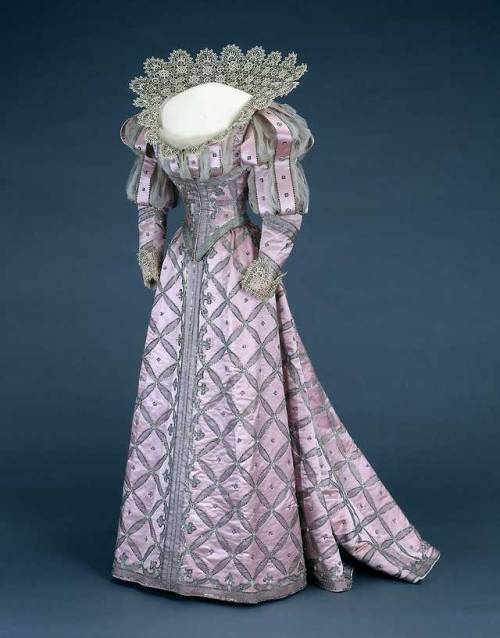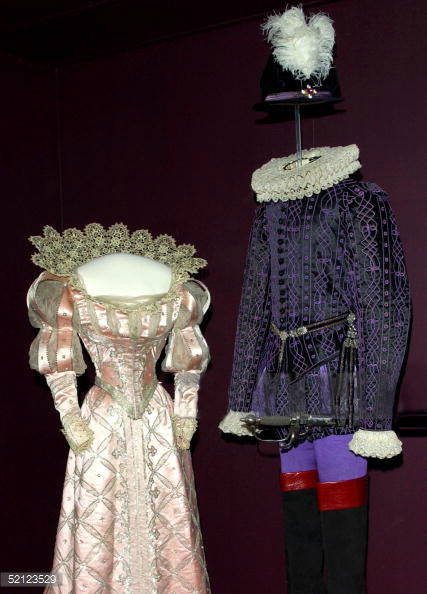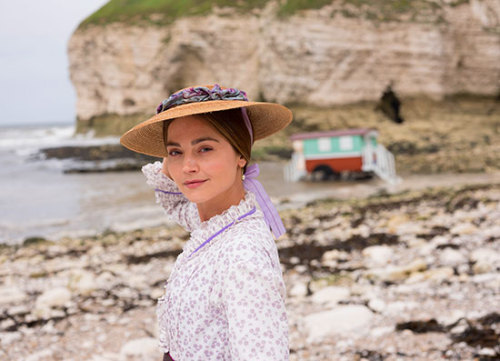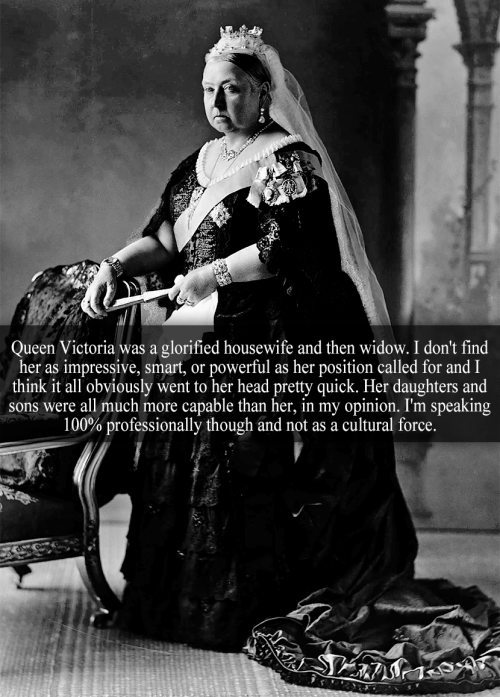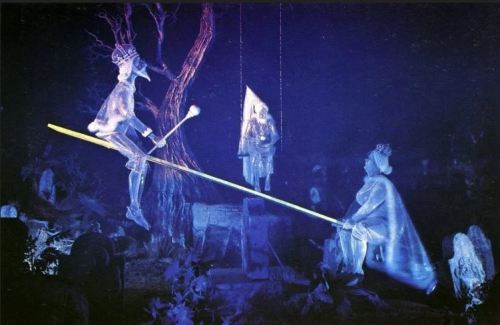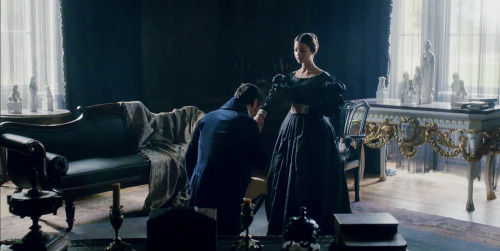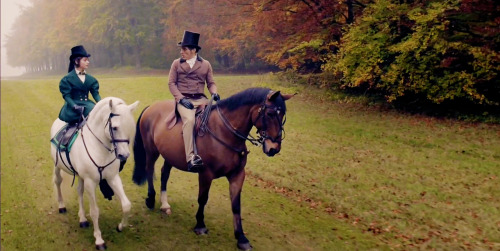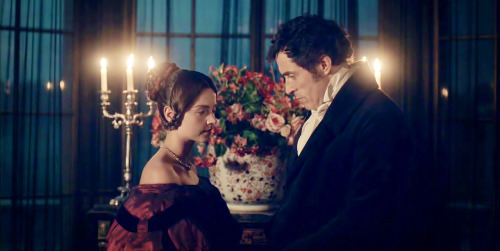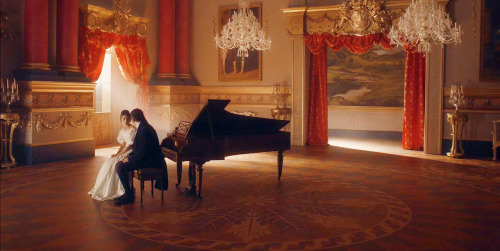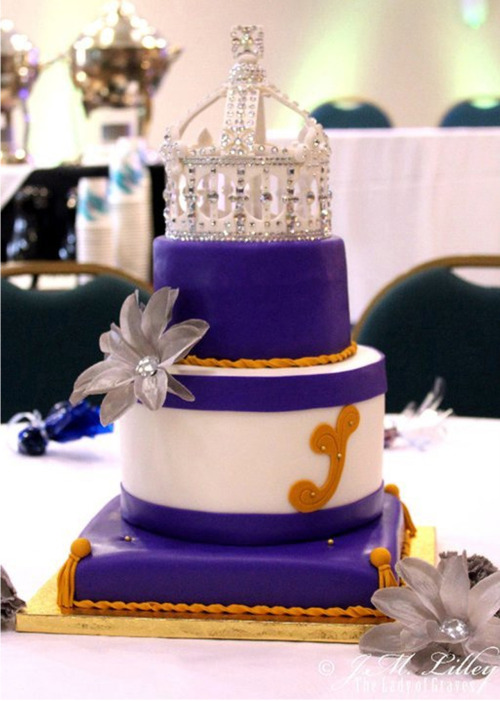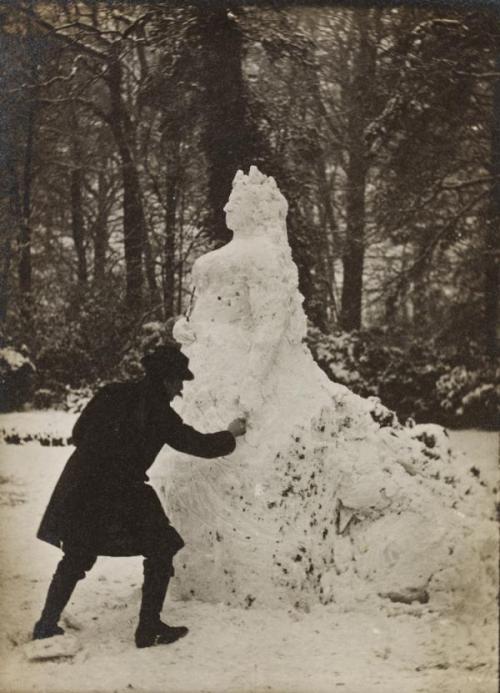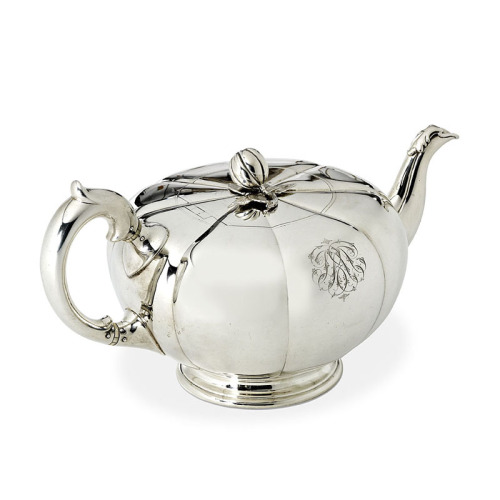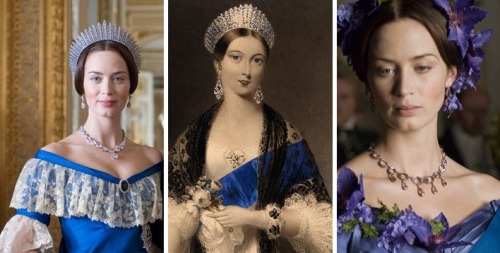#queen victoria
Costumes worn by Prince Carl (later king Haakon of Norway), princess Maud (later queen Maud of Norway) and princess Victoria, photographed by Lafayette on July 2, 1897, and two of the attires worn. The Lafayette photo comes from the Royal Archives at Windsor.
The occasion was a grand fancy dress ball hosted in London by the Duchess of Devonshire, in honour of queen Victoria’s 1897 Jubilee. Whereas the queen herself was not at the ball, many of her closest family members were.
The theme of the ball was allegorical or historical (pre 1815) figures. The Prince of Wales, later king Edward VII, came as grand prior of “The Order of St. John of Jerusalem”, while his wife Alexandra came as the French Renaissance queen Marguerite de Valois.
Their daughers were dressed as Renaissance ladies-in-waiting to the “Marguerite de Valois”, in similar corseted, slashed and collared dresses, while Danish prince Carl appeared as a Danish Renaissance courtier. I have never been able to find out the colour of princess Victoria’s dress. But the garments of her sister and brother in law were predominantely pink, purple and metallic. This we know because their attires are wonderfully preserved!
Princess Maud’s attire was made by French Morin-Blossier. The main fabric is a pink silk satin, appliquéed with sheer silk fabric in a diagonal pattern. The silk has then been embellished with silvery sequins and beads. In addition there’s paned sleeves and bodice details with the same sheer silk poking through, and a Recitella-style standing collar and cuffs.
It is not known who made prince Carl’s attire. But it is made of a black silk satin elaborately embroidered with silk and beads. In addition elastic purple hoses of wool and silk, thigh-high black boots, lace collar and cuffs, and a merallic belt with sword. And not to forget the matching tall, plumed hat. To look the part, the prince even wore a fake beard, to get the proper Renaissance look!
Today the costumes are is in the care of The National Museum in Oslo (OK-1991-0256 and OK-1991-0251).
Post link
Let me say that: happier is written by Lord M after Vicky wedding.

I hope you’re happy, just not like how you were with me
I’m selfish, I know, can’t let you go
So find someone great, don’t find no one better
Ihope you’re happy, but don’t be happier
(viaOn Victoria: Who Were the Chartists?) Before you watch the first episode of Victoria, Season 3 on PBS Masterpiece on Sunday, you’ll want to read this. Who were the Chartists?
Post link
(viaPBS Masterpiece Schedule Spring 2019) The MASTERPIECE | PBS Winter / Spring Period Drama Schedule is here! It all starts this weekend with Victoria. You’ll also want to see the list of other programs coming to PBS, that fans of historical dramas will love. https://www.willowandthatch.com/2019-pbs-masterpiece-period-drama-schedule-winter-spring/
Post link
Queen Victoria, c 1894, w 3 Kings
King Edward VII - Son
King George V - Grandson
King Edward VIII - Great Grandson
Post link
“Queen Victoria was a glorified housewife and then widow. I don’t find her as impressive, smart, or powerful as her position called for and I think it all obviously went to her head pretty quick. Her daughters and sons were all much more capable than her, in my opinion. I’m speaking 100% professionally though and not as a cultural force.” - Submitted by Anonymous
Post link
There’s a theory that i like : In the Haunted Mansion’s Graveyard scene, there is a section with a king and a queen playing teeter-totter on a tombstone. These characters look like real historical figures King James the 1st of England (1566 -1623) and Queen Victoria (1819-1901). Both these royals were heavily involved with America where the mansion is located. The country was colonized under Jame’s reign and the industrial revolution spreaded under Victoria’s reign. There’s a lot of victorian influence and style in the ride. This also could be a visual pun with the expression “Playing Victoria and Albert”, even though the king is not Prince Albert, the Queen’s husband. This expression comes from the passionate relationship Victoria had with her beloved husband, which was rare for royals commonly used to arranged marriages.
Post link
Hello. We’ve been writing this blog every day for around eleven and a half months now. As it was our intention to find out why every single day of the year is BRILLIANT, we’re almost there and it seemed appropriate to have some sort of countdown. If we make it, there will be thirteen more posts after this one. You can also find this blog on Wordpress, along with a short explanation of how it came about, and in which we reveal which of us has actually written all of this on the ’about’ page. Thank you all for reading, liking and re-posting.
Why March 2nd is BRILLIANT
A Poem for the Queen
On this day in 1882, Queen Victoria survived her eighth and final assassination attempt. We were surprised to find out that Queen Victoria had been such a regular target. So we thought we’d take a closer look at who these people were. The first attack was in June 1840 when she was pregnant with her first child. Victoria and Albert were out driving in their carriage when Edward Oxford fired two pistols at them. Both shots missed. He was arrested and afterwards sent to Australia. He said he had done it for the notoriety it would bring him.
We were even more surprised to find out that attempts two and three were carried out on two consecutive days, in 1842, by the same man. John Francis was an angry out of work stage carpenter and failed tobacconist who felt he deserved better in life. On the first occasion, his gun failed to go off. He was only seen by Prince Albert and one other person. The next day, the Queen and Prince somewhat recklessly agreed to go out again to see if he would put in another appearance. This time Robert Peel, who was then Prime Minister, had several police officers stationed along the route. One of these was Constable William Trounce. He had been watching a rather furtive looking man for some time. But as the Queen’s carriage approach, he was torn between the job he was meant to be doing and showing respect for his queen. He chose wrong. He decided to salute her. John Francis chose that moment to fire his weapon. Luckily the shot missed and the constable was able to arrest him. John Francis was sentenced to be drawn, hanged and quartered which is not quite the same thing as being hung, drawn and quartered. A condemned person would be drawn (dragged) on a hurdle to the place of execution, hanged until dead and then cut into four parts. His sentence was later commuted to transportation for life. Constable Trounce did not lose his job.
Shortly after that, there was a fourth attack. This time by a man called John Bean. His pistol, which was loaded with paper and bits of broken clay pipe, failed to go off. It seemed like there was a bit of a mania for taking pot-shots at the Queen. Oddly, Robert Peel responded by making it a lesser crime punishable, not by hanging, but by flogging and imprisonment. Even more oddly, it seemed to work. There were no more attempts for another seven years. We don’t know if Queen Victoria ever used the parasol lined with chain-mail that she was given for protection.
In 1849 she was shot at by William Hamilton. He was an unemployed bricklayer who felt he would have a better life in prison. He was jailed on Gibraltar for seven years. Her fifth attacker was Robert Pate in 1850. He is generally described having been often seen behaving eccentrically in London Parks. We tried to find out more but just came up with the fact that his clothes were unusual and there was a vague mention of goose stepping. He was the only one who actually hurt her. He hit her on the head with his stick, giving her a black eye and a scar that lasted for ten years. The Queen insisted on attending the opera a few hours later just so everyone could see that she hadn’t been badly hurt. Her ladies in waiting insisted that she shouldn’t go, as she clearly was hurt. “Then” she said, “they will see how little I mind.”
Her sixth attacker, in 1872, was a young Irishman who imagined himself a martyr to the cause of Irish Nationalism. He wanted her to sign a document he had written which ordered the freeing of Irish political prisoners. He expected to be shot by firing squad and die a hero. But the Queen’s servant and very good friend John Brown knocked the pistol from his hand. He was arrested and sent to Australia.
This brings us to March 2nd 1882 and Roderick Maclean. Maclean had suffered a head injury in 1866, declared of unsound mind in 1772 and committed to an asylum in 1880. However, in 1882, he was pronounced ‘cured’ and released. From that time, he had wandered about the country, convinced that anyone wearing the colour blue would cause him harm, as would anything to do with the number four. He had sent a poem to the Queen which had been rejected on her behalf by one of her ladies in waiting and he was upset about it. He sold his scarf and concertina, bought a gun and headed for Windsor. He managed to take a single shot at Victoria before he was grabbed by some Eton schoolboys and hit over the head with an umbrella. He was probably the only one of her attackers who was completely insane. He was committed to Broadmoor Criminal Lunatic Asylum for the rest of his life.
We don’t know what his rejected poem was, but we can tell you about another poem connected with the incident. It is by William Topaz McGonagall, who many consider to be the worst poet in the English language. We’re definitely not going to inflict all of it on you, but here’s a snippet:
God prosper long our noble Queen,
And long may she reign!
Maclean he tried to shoot her,
But it was all in vain.For God He turned the ball aside
Maclean aimed at her head;
And he felt very angry
Because he didn’t shoot her dead.
Post link
Crack theory: Sins of the dead
@stainedglass-wings had some late night thoughts and shared them on another post, and it got me to thinking. I still think the last initials of the lockets could represent musical notes, and the order could represent a leitmotif.
However, this new idea would shed light on the motives for their deaths, since I think we can probably all agree they didn’t die simply from natural causes. And then Yana-san had to choose specific words for these things, so that the initials could still represent musical notes and not repeat each other (wouldn’t be confused which locket was for which thing).
But what do I mean by “things”? Sins. Cardinal or deadly sins. This would be another parallel to s1’s Ash Landers’ obsession with purging the world of “impure” humans. And it would work very well, if John Brown turns out to be an angel or something bent on a deranged version of divine justice.
Ok, so here are the lockets again, with their order:

Emile C.–Lust. The “C” could stand for “cravings”. Lust is sometimes thought of as a type of gluttony, and “cravings” (as well as “appetite”) can describe aspects of one’s libido just as well as one’s desire for food. So, this Emile fellow (if Yana-san isn’t playing with name genders again) could have been killed for the sin of lust. And considering I’ve long thought the “C” might be for the name Chambers (the Viscount of Druitt’s family name), this would make sense. The Chambers line could have a particular penchant for the more lustful or hedonistic pursuits.
Oliver A. –Avarice. That’s an extreme form of Greed. I have no idea what last name this would be or where they might fall into place within the narrative, but this Oliver dude might have been seen as far too greedy for his own good.
Alex B.–Blasphemy. It’s not what’s typically listed as one of the “seven deadly sins”, but it’s considered one of the unforgivable ones. I came to this one because I couldn’t think of a “b” word for Wrath. However, when our earl watched his older twin being stabbed to death, his unbridledanger led to him making a blasphemous statement. That blasphemy is apparently what really interested the demon that was summoned.

So, Alex could have been blasphemous and/or wrathful. Again, I don’t know what last name the “B” might be.
Cloudia/Claudia P.–Pride. We know the Phantomhives can be a prideful lot, and Vincent says the Phantomhive women tend to be particularly strong-willed. Apparently, Undertaker repeatedly warns them about it, too… saying they keep losing touch with the fact their power comes from support they receive from others, and how they will fall if they lose that support. Our earl wearing that ring like a collar around his neck by his own volition also seems to be a matter of pride, and Undertaker warns it could end up “choking” him someday. So, perhaps our earl’s grandmother was a particularly prideful sort of person. Vincent might have been, too. Francis/Frances sure seems to be….
Molly/Mally G.–Gluttony. No idea who she is, but she’s the one who died first, among the people represented by lockets. I’m reminded by some old research I did on Queen Victoria and her early scandals, back when she was new to the throne. She ascended the throne in 1837 (coronated in 1838), and an early scandal involved a female servant whom Victoria accused of getting pregnant out of wedlock. Her belly was so swollen that she looked pregnant, but it turned out to be a horribly large tumor in her abdomen. I had once wondered if Molly/Mally was a Kuroverse version of that unfortunate woman. The possible “sin of gluttony” reminded me of that swollen belly mistaken for pregnancy. And pregnant people are said to be “eating for two”…. It’s a long-shot, but she could have been a royal servant repeatedly caught stealing food, or something? Accusations against her could have been some huge misunderstanding, too, particularly if Victoria acted against her before John Brown was by her side… or if he was there and knew the truth but did the queen’s bidding anyway. It seems like a weak motive to kill someone, but the queen might not see it that way. Not if she truly believes the person is committing a deadly or unforgivable sin.
Gilbert D.–Dejection. That’s the term sometimes used by the orthodoxy instead of Sloth. Gilbert could have been someone who was too overcome by depression or even just apathy. If we are talking about someone who specifically pissed off the queen, it could be that he neglected to follow her orders. I used to think the “D” could stand for Dalles/Durless, which is apparently Madam Red’s married name. If the death was in 1885, it could have been Madam Red’s husband, supposedly killed in that carriage accident, but I don’t think the accident was really an accident. He was the Baron of Burnett, and he showed deep affection for his wife and unborn child, despite the fact Madam Red was still in love with Vincent. If it was him (another long-shot), then he could have been killed for not giving a toss about the queen’s intentions or goals. If the death was in 1862, as one image of the locket shows, then who knows. March 1, 1862 was a few months after Prince Albert died, so it could have something to do with Albert’s death. Like a physician whom the queen blames for not doing enough to save her beloved Albert’s life. This is me using a lot of words to say idk who Gilbert is.
Harry E.–Envy. How Harry’s envy leads to him being targeted for death, idk. I also have no clue who he might be. Perhaps he was envious of the queen herself. There were many attempts on her life, especially early in her reign. I found a total of 8 known attempts on her life, committed by 7 different people (one failed twice), but none of them happened in 1851. However, Vincent was born in 1851. Harry could have been involved in some plot to kill or overthrow the queen. Otherwise, I got nothin’.
Well, I don’t know if any of this will pan out, but it sure is an interesting idea! Also, it doesn’t take anything away from my leitmotif theory, so I kind of like it. We all want to know why and how these people died, right? Deeply hidden clues about their “sins” is a cool concept, and I think it’s still worth pursuing, even if their last initials don’t end up being that clue.
I can’t go on, won’t go on Living on, without you…
A man carving Queen Victoria out of snow on a winter’s day around 1890. Unfortunately the identity of the patriotic sculptor is unknown.
Post link
A Silver Teapot by Robert Garrard,
In the form of a stylised melon with reeded sides, the finial in
the shape of a seed pod.
The teapot is inscribed ‘From Victoria R. Christmas 1876’
Maker’s Mark: ‘RG’ for Robert Garrard
London, 1867 (inscription later)
John Brown became the personal servant of Queen Victoria in 1861, following the death of Prince Albert. The Queen was inconsolable after the death of her much loved husband and she retired from public life, to cope with her grief. Brown became a most valued friend and confidant during this difficult time.
Indeed, it was the closeness of their relationship that caused many rumours. The Queen allowed Brown to address her in a peculiarly
informal manner and Victoria’s own children nicknamed Brown ‘Mama’s lover.’ Edward Stanley was outraged when he learnt that the Queen and
Brown shared adjoining rooms, as he wrote in his diary that it was “contrary to etiquette and even decency.”
When Brown died in 1883, it sparked another wave of grief for Victoria (although in this instance, it could not have been as public as her
grief for Prince Albert).
Post link

Queen Victoria 1894 zu Besuch in Coburg anlässlich der Vermählung ihrer beiden Enkelkinder Prinzessin Victoria Melita v. Sachsen-Coburg und Großherzog Ernst Ludwig v. Hessen
awt ex ©️staatsarchiv coburg





